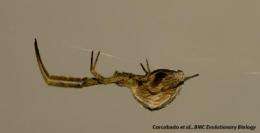Why are male spiders small while females are giant?

'Bridging', an unusual mode of getting around frequently used by vegetation-inhabiting spiders to cross large gaps, may partly explain the tendency for male spiders to be much smaller than females. Researchers writing in the open access journal BMC Evolutionary Biology studied bridging, in which spiders use the wind to carry a strand of web to their destination and then clamber upside down along the resulting bridge, finding that small size was associated with a greater ability to carry out the maneuver.
Guadalupe Corcobado, from the Spanish National Research Council, worked with a team of researchers led by Jordi Moya-Laraño to investigate the spiders' behavior in a laboratory wind tunnel. She said, "In species where bridging is a very common mode of locomotion, small males, by being more efficient bridgers, will enjoy more mating opportunities and thus will be better at competition to reach receptive females. This may lead to a selective pressure for smaller size."
The researchers investigated 204 spiders from 13 different species. They suggest that females do not feel the same pressure to be smaller as, for them, a larger body size confers and advantage in generating offspring. Corcobado emphasises that this 'bridging' theory to explain size differences between the sexes is not incompatible with other hypotheses. She said, "Previous studies have suggested that female fecundity was the main driver of extreme male and female size differences. However, fecundity alone could not explain why males may grow as large as giant females in some species but remain extremely small in others. A selective pressure against large male body size has been searched for by researchers since Darwin; the constraint on bridging seems to be such a selective pressure".
More information: Introducing the refined gravity hypothesis of extreme sexual size dimorphism, Guadalupe Corcobado, Miguel A. Rodriguez-Girones, Eva De Mas and Jordi Moya-Larano, BMC Evolutionary Biology (in press), www.biomedcentral.com/bmcevolbiol/
Provided by BioMed Central

















